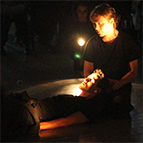
Sharon Dodua Otoo, May 27, 2014
In this paper, which was also presented at the IRC symposium Blackface, Whiteness and the Power of Definition in Contemporary German Theatre, the author focusses on how whiteness is represented in modern German theatre, using Michael Thalheimer’s 2012 production of Dea Loher’s play Unschuld as an example. 

Julia Lemmle, May 20, 2014
Daniele Daude, May 12, 2014
Based on a presentation during the IRC symposium Blackface, Whiteness and the Power of Definition in Contemporary German Theatre, this essay explores which set of filters are used by white artists and academics to (re)create race on the opera stage. In order to understand this nexus of practices and discourses, the essay employs the concept of racialization, focusing on three filters in particular: racialized dramaturgy, the racialized stage, and racialized embodiment. 

Michael Roes, April 3, 2014
 “Why do we busy ourselves in foreign countries?” is one of the central questions asked in all the debates on neo-colonialism. By “we,” panellists usually think of the ‘West,’ or the ‘Occident.’ And as “foreign” they preferably designate all non-European and North American countries. – And, of course, the anti-neo-colonialist’s answer to these questions is a strident “For no reason whatsoever!” Such debates tend to provoke polarising contributions …
“Why do we busy ourselves in foreign countries?” is one of the central questions asked in all the debates on neo-colonialism. By “we,” panellists usually think of the ‘West,’ or the ‘Occident.’ And as “foreign” they preferably designate all non-European and North American countries. – And, of course, the anti-neo-colonialist’s answer to these questions is a strident “For no reason whatsoever!” Such debates tend to provoke polarising contributions … 
 “Why do we busy ourselves in foreign countries?” is one of the central questions asked in all the debates on neo-colonialism. By “we,” panellists usually think of the ‘West,’ or the ‘Occident.’ And as “foreign” they preferably designate all non-European and North American countries. – And, of course, the anti-neo-colonialist’s answer to these questions is a strident “For no reason whatsoever!” Such debates tend to provoke polarising contributions …
“Why do we busy ourselves in foreign countries?” is one of the central questions asked in all the debates on neo-colonialism. By “we,” panellists usually think of the ‘West,’ or the ‘Occident.’ And as “foreign” they preferably designate all non-European and North American countries. – And, of course, the anti-neo-colonialist’s answer to these questions is a strident “For no reason whatsoever!” Such debates tend to provoke polarising contributions … 
Stephen Barber, February 20, 2014
 This essay is based on a paper the author presented during the Symposium Dumb Type – The Birth of New Media Dramaturgy at Freie Universität Berlin in April 2013. It focuses on Lovers (1994) – the first moving-image installation work of Teiji Furuhashi, viewed within the framework of the histories of immersive moving-image projection environments involving human figures in performative movement. Alongside Lovers, it examines a film-projection experiment, The Birth, shown at the Expo ’70 in Osaka involving the work of Tatsumi Hijikata. The final part of this essay extends back to 1893 to look at the originating event for all projections of moving-images within specially-designed, enclosed spatial environments: Eadweard Muybridge’s project to create the first-ever space for the projection of moving-images to public audiences, through the construction of his ‘Zoopraxographical Hall.’
This essay is based on a paper the author presented during the Symposium Dumb Type – The Birth of New Media Dramaturgy at Freie Universität Berlin in April 2013. It focuses on Lovers (1994) – the first moving-image installation work of Teiji Furuhashi, viewed within the framework of the histories of immersive moving-image projection environments involving human figures in performative movement. Alongside Lovers, it examines a film-projection experiment, The Birth, shown at the Expo ’70 in Osaka involving the work of Tatsumi Hijikata. The final part of this essay extends back to 1893 to look at the originating event for all projections of moving-images within specially-designed, enclosed spatial environments: Eadweard Muybridge’s project to create the first-ever space for the projection of moving-images to public audiences, through the construction of his ‘Zoopraxographical Hall.’ 
 This essay is based on a paper the author presented during the Symposium Dumb Type – The Birth of New Media Dramaturgy at Freie Universität Berlin in April 2013. It focuses on Lovers (1994) – the first moving-image installation work of Teiji Furuhashi, viewed within the framework of the histories of immersive moving-image projection environments involving human figures in performative movement. Alongside Lovers, it examines a film-projection experiment, The Birth, shown at the Expo ’70 in Osaka involving the work of Tatsumi Hijikata. The final part of this essay extends back to 1893 to look at the originating event for all projections of moving-images within specially-designed, enclosed spatial environments: Eadweard Muybridge’s project to create the first-ever space for the projection of moving-images to public audiences, through the construction of his ‘Zoopraxographical Hall.’
This essay is based on a paper the author presented during the Symposium Dumb Type – The Birth of New Media Dramaturgy at Freie Universität Berlin in April 2013. It focuses on Lovers (1994) – the first moving-image installation work of Teiji Furuhashi, viewed within the framework of the histories of immersive moving-image projection environments involving human figures in performative movement. Alongside Lovers, it examines a film-projection experiment, The Birth, shown at the Expo ’70 in Osaka involving the work of Tatsumi Hijikata. The final part of this essay extends back to 1893 to look at the originating event for all projections of moving-images within specially-designed, enclosed spatial environments: Eadweard Muybridge’s project to create the first-ever space for the projection of moving-images to public audiences, through the construction of his ‘Zoopraxographical Hall.’ 
Omar Elerian, February 6, 2014
The International Research Center “Interweaving Performance Cultures” opened the academic year 2013/14 with an international symposium entitled European Perspectives on Postmigrant Theatre. On this occasion, Omar Elerian, Associate Director at the Bush Theatre in London, offered 5 provocations on how British theatre can be affected in order to embrace change and contribute to building a cultural capital that will impact the next generation, regardless of its cultural or geographical heritage. 

Azadeh Sharifi, December 18, 2013
Black artists, indeed all artists of color, are traditionally underrepresented in contemporary German theatre. This paper reflects on the debate on blackface in a broader context. It argues that the criteria used to justify blackface are similar to those explaining the underrepresentation of artists of color in German theatre in general. The three major questions posed are: Who is represented on stage? Whose perspective is shown? And for whom is this art made? 

Sandrine Micossé-Aikins, December 4, 2013
A lot has been said and written in the recent months about the use of blackface in German theatre (and other cultural) productions. Mainstream positions that keep surfacing in these debates are based almost without exception on a deep lack of critical knowledge about Germany’s colonial past as well as the history of blackface, but also the complete underestimation of the power inherent to images and words. At the same time, the intensity of the reactions to anti-racist criticism in the cultural domain suggests, that there is indeed a, if subconscious, awareness of a historical “right” to psychological and corporeal violence against (former) colonial subjects that is now being endangered. This essay challenges four of the most popular misconceptions about this subject by taking a deeper look at the intrinsically linked mechanisms of identity, race and representation in Germany. 

Rustom Bharucha, September 18, 2013
 On the occasion of the conference DANCE/BODY AT THE CROSSROADS OF CULTURES, which took place in Nicosia, Cyprus in June 2011, Rustom Bharucha presented the opening keynote lecture on the notion of the dance body, movement, transformation, and the politics of touch.
On the occasion of the conference DANCE/BODY AT THE CROSSROADS OF CULTURES, which took place in Nicosia, Cyprus in June 2011, Rustom Bharucha presented the opening keynote lecture on the notion of the dance body, movement, transformation, and the politics of touch.
Listen to the lecture here.
 On the occasion of the conference DANCE/BODY AT THE CROSSROADS OF CULTURES, which took place in Nicosia, Cyprus in June 2011, Rustom Bharucha presented the opening keynote lecture on the notion of the dance body, movement, transformation, and the politics of touch.
On the occasion of the conference DANCE/BODY AT THE CROSSROADS OF CULTURES, which took place in Nicosia, Cyprus in June 2011, Rustom Bharucha presented the opening keynote lecture on the notion of the dance body, movement, transformation, and the politics of touch. Listen to the lecture here.

Matthias Lilienthal, August 2, 2013








